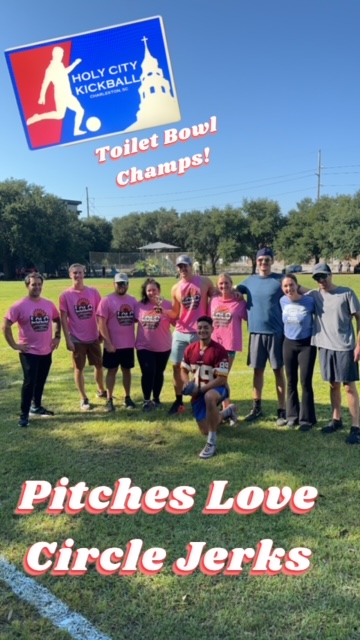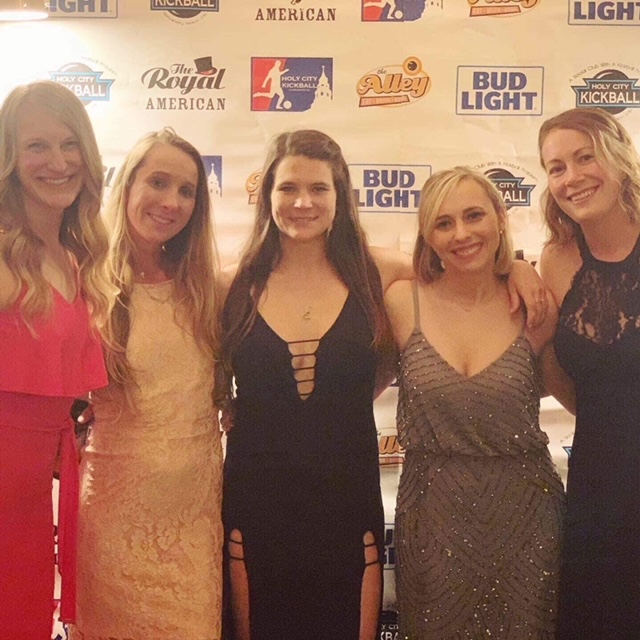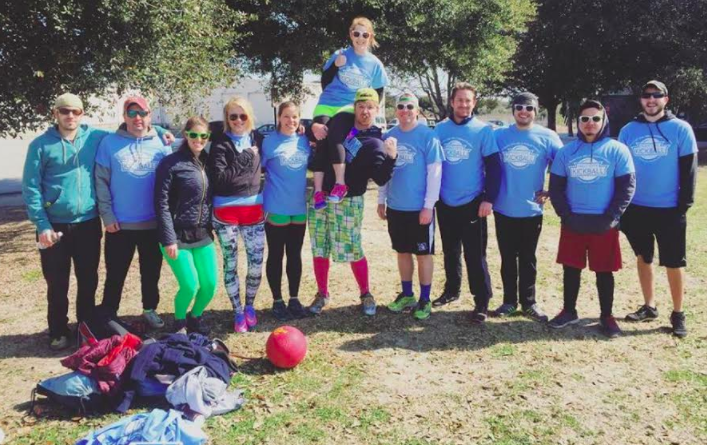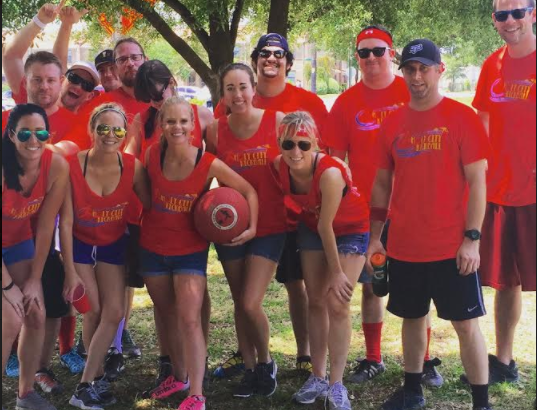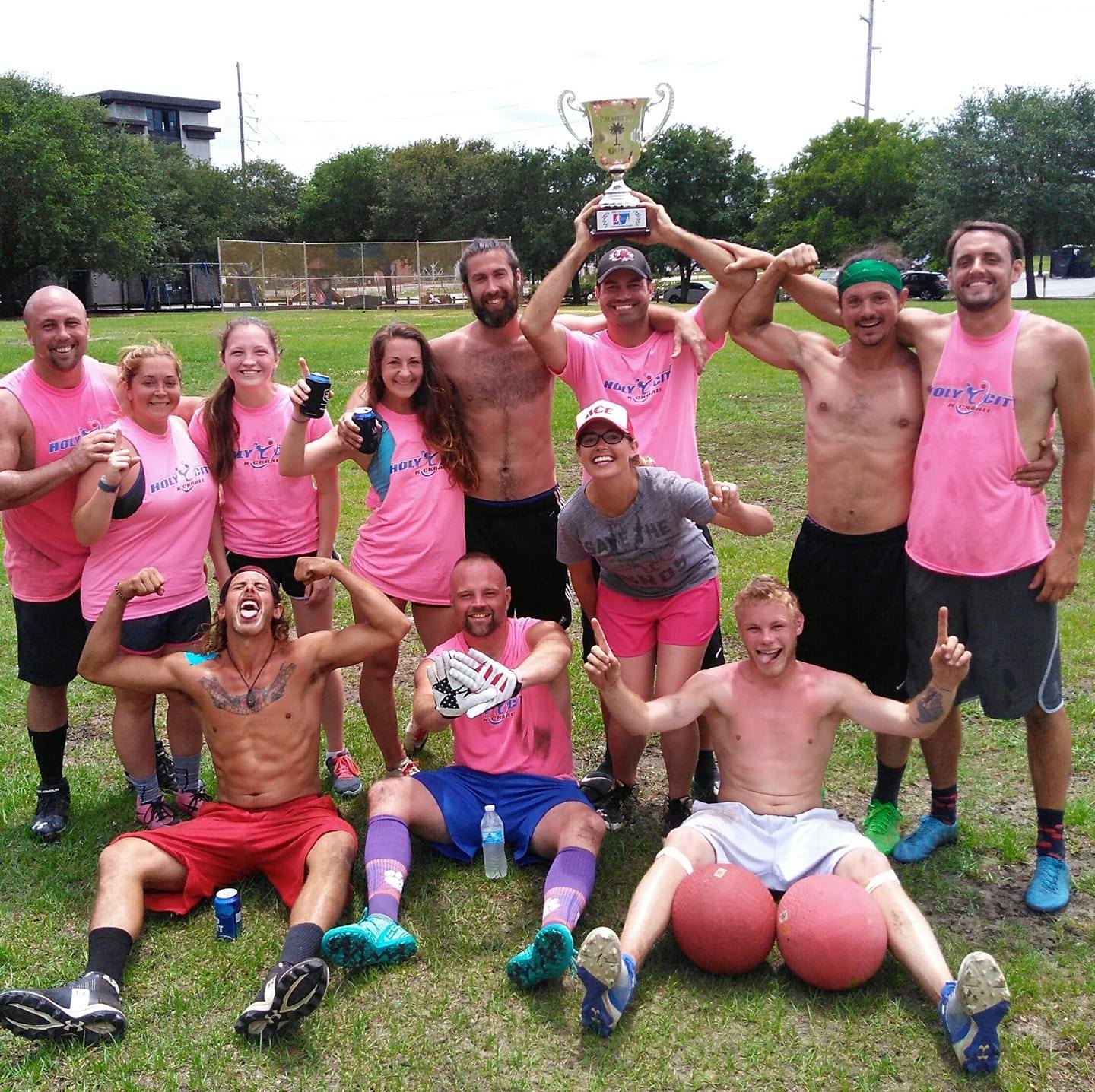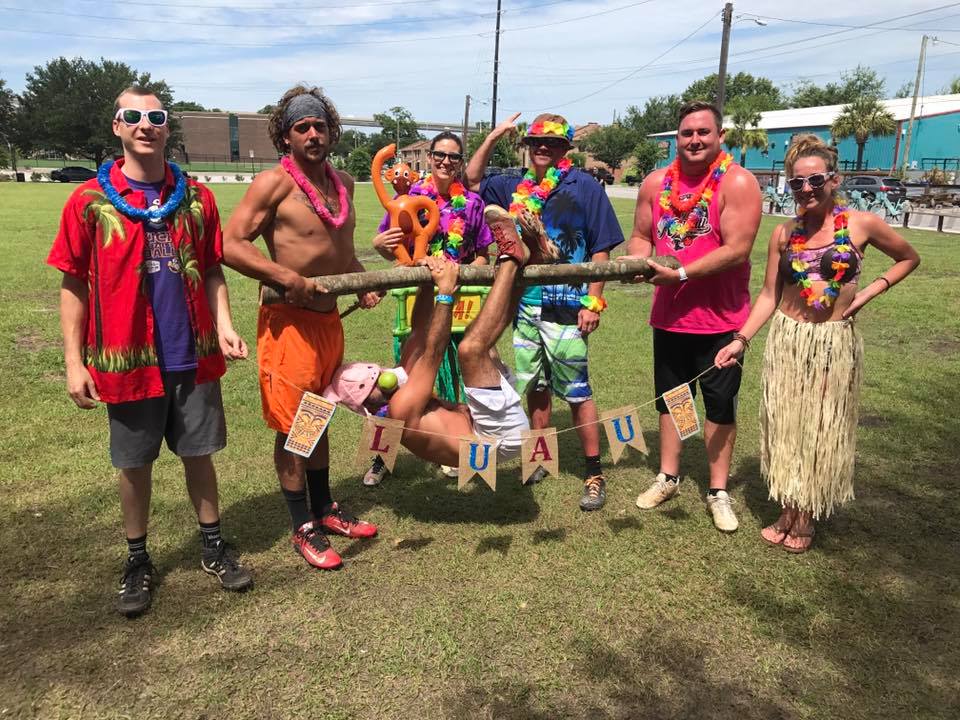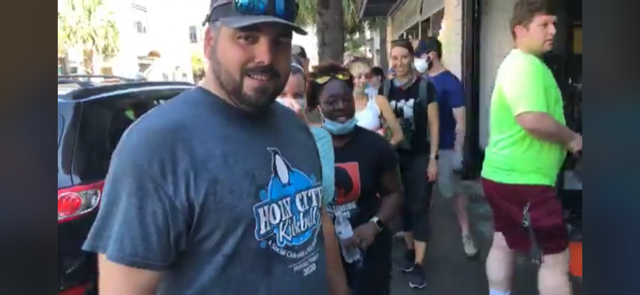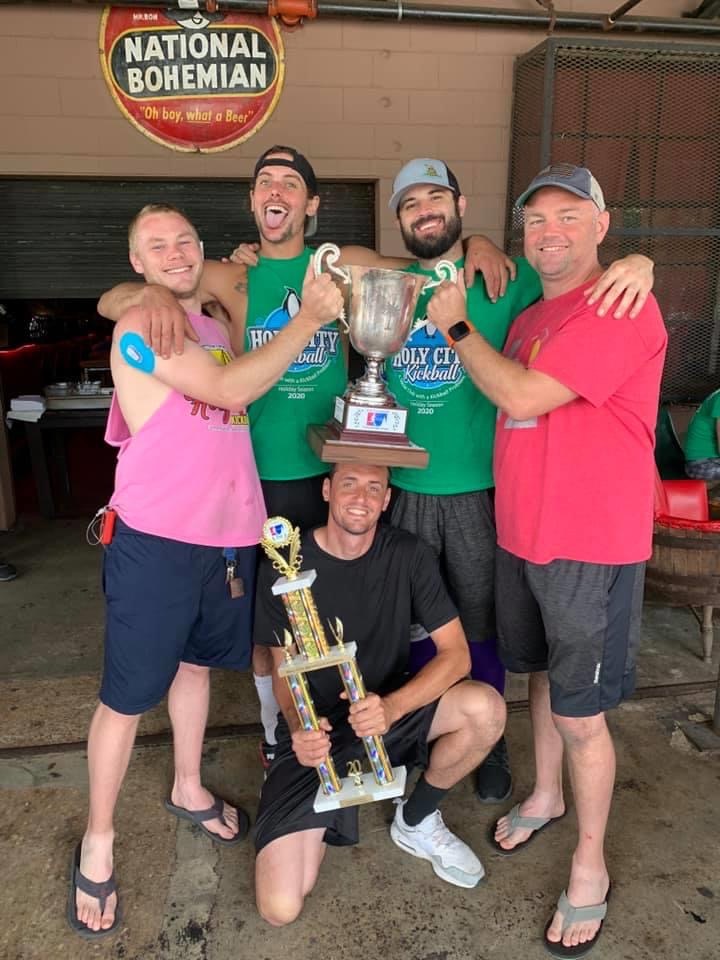Official Holy City Kickball Rules
Standard baseball rules will be used along with the following changes and kickball specific rules added on.
General:
- Lineups by each team must have no more than 2 males kicking in a row and may not change at any point during regulation.
- Minimum number of players to begin a game is six (2 girls and 4 guys) and all players must be wearing their team shirt to play.
- If a team does not have enough players to begin the game 10 minutes after the scheduled game time, that team will forfeit (At the discretion of the opposing team).
- A team may use up to 10 players in the field on defense using standard baseball positions with one extra outfielder and four of the teams defenders must be females.
- If a team only has 3 or 2 females to play, that team may not use more male players to fill in (Maximum of 6 male players).
- The catcher position may only be switched once per inning but any other position may be switched as often as the team likes.
- Once a team scores nine or more runs in one inning that half of an inning will be over unless this occurs in the last inning, where there is no limit on runs scored.
- Games will last 50 minutes or nine innings, whichever comes first and if the game is tied at the end of regulation the referee will ask each captain if they would like to play one extra inning. If both captains agree to keep playing then one extra inning will be played and each team can choose to begin at the top of their lineup or stay where they are currently in their lineup. If one or neither captain wants to keep playing or the game is still tied at the end of the extra inning the game will end in a draw. Playoff games will be played until there is a winner.
Offense:
- Each player will start with one ball and one strike when they first come up to bat.
- The strike zone will extend to one foot on either side of home plate and if a pitch touches any part of the strike zone lines, it will be called a strike.
- Any pitch that bounces higher than one foot off the ground as it crosses the plate will be called a ball.
- Pitches should be thrown at medium speed and not be intentionally spun. If at any point during the game, the kicking team believes the pitcher is throwing too fast or spinning they should let the referee know and the referee may issue a warning to the other team to stop and any further illegal pitches will count as a ball.
- If a kicker kicks the ball before it crosses the front of home plate the ball will be called a foul ball automatically no matter where the ball is kicked and may still be caught to get the kicker out. A foul ball will count as a strike even if the player already has two strikes against them (Kick two foul balls and you will be out).
- If a player accumulates four called balls they will be awarded first base. The player may opt out of walking and wait for a kickable pitch if they would like to. If the batter chooses not to walk, the count will be reset to 1 and 1.
- Any player on your team may be in your lineup or left off but if a player plays on defense at any time, they MUST be in your kicking lineup. Lineups may not be changed after the game begins.
Base Running:
- Base runners may not lead off, steal or slide. If a player is caught doing any of these things they will be called out.
- If a live ball hits a base runner while the base runner is in fair territory the runner will be called out.
- Base runners will always have the right to a clear path to the next base unless a defender is making a play on the ball. If a defender blocks a base runner while not making a play on the ball the runner will be called safe and may be awarded one extra base at the referee's discretion.
- If a runner is injured on a play, the last batter to get out that is the same sex may replace that player and the injured player will be not be allowed to kick again for the remainder of the game.
- On a tag up, a base runner may leave their current base as soon as a defender touches the ball.
- If a runner intentionally knocks the ball out of play then the runner is out and the play is dead.
Defense:
- On defense, a play will be called dead once any player has the ball within 10 feet of the pitcher's mound AND they are not attempting to immediately make another play.
- Once a play is called dead by the referee, any runner that is not at least halfway to their next base will be called back to the base they were previously on unless the pitcher chooses to throw the ball before the play is called dead.
- A defender may tag or hit a player with the ball to get them out and the ball is still live until the pitcher controls it near the pitcher's mound.
- If a defender targets a runner's head intentionally the runner will be called safe.
- If an overthrow goes out of play, all runners may advance only one more base.
- If a defender attempts to kick the ball to another defender and the ball goes out of play, runners may advance until the play is over.
- All outfielders must play at least 10 feet behind the baselines and the catcher must remain at least 4 feet behind the plate until the ball is kicked.
- All other players may not cross the line that connects first base and third base until the ball is kicked.
- There is NO infield fly rule.
Kicking:
- All kicks made by male players must reach the baselines on the field to be called fair (Line from first to second base or the line from second to third base).
- All kicks made by female players must go beyond the arc painted 9ft in front of home plate.
- Any kick not reaching these lines will be called a foul ball.
- If a ball is picked up by a defender at any point before it reaches these lines it will be automatically called fair so long as it is also in fair territory.
- If a ball is rolling in foul territory and picked up by a defender with at least one foot in fair territory the ball will become a fair ball.
Misc.:
- A referee's call is always final and he/she will always be courteous to players and we encourage players to do the same.
- Any rule that a team may want to bend for a game (Like 10 mins until a forfeit or number of players) may be bent as long as both captains agree and the referee is made aware.
- Metal cleats and alcohol are prohibited! Our goal is to make the game as fun as possible for everyone so remember to treat everyone on your team and other teams with respect.
- No vehicles are allowed on the field. Parking alongside the park only.
NEW RULE Effective 9/30/18: The Sub Rule
- During the regular season, if a team is short players and wants to add players from other teams to their lineup for that day, that team must clear each substitute player with the opposing team. If the subs are okayed, the team adding these players will immediately give one run to the opposing team for each sub they added. If the sub is not okayed by the opposing team, they will not be allowed to play.
- Any subs who do not play in the league can be brought in to play your regular season game without penalty or risk of the opposing team being able to veto the addition. If that player decides to help in any other games during the day, they will be subject to the rule as stated above. Subs for playoff games must be submitted to the league ahead of time.
- Teams may make deals in order to have subs play (ex. Player X can't play pitcher). As long as both teams agree prior to the first pitch of the game, the decision is final and the umpire will have the final say on what is allowed.
NEW RULE Effective 12/3/17: The Challenge Rule
- If one team believes that a play call may have not been correct, the team captain (or acting captain if captain is absent) may request a challenge from the umpire. If the umpire believes the play called is 100% correct, he/she will deem the play non-challengeable. If the umpire believes the play is challengeable, both teams will pick one player from their team to play rock, paper, scissors against the other team. Best 2 out of 3 wins. If the challenging team wins, the call is reversed. If the challenging team loses, the play stands as called.
- Teams will be issued ONE challenge per game, not to be used after the umpire has called LAST INNING or if the game is in the 9th inning or overtime.
- The umpire has the final call on all aspects of this rule. If a call is deemed non-challengeable, the call must be respected.
- This rule is only available during the regular season.
NEW RULE Effective 5/7/17: The Volleyball Rule
- If one team is winning by 10 or more runs at any point in the game, that team will be subject to this rule. When this team is on defense, they may no longer simply catch a fly ball. They must "bump" or "set" the ball to ANOTHER player on their team to try to catch it for the out. If a player does catch a fly ball without bumping or setting the ball, the kicker will be called safe. Once the defending team is longer up by 10 or more runs, the volleyball rule will immediately no longer be in effect.
- Update 3/11/23: The team that is ahead by 10 is no longer allowed to bunt
- For every additional 5 runs that the winning team goes up by, they must bump or set the ball one additional time and no single player can be used twice. (Example: If a team is up by 21, when the other team kicks a ball into the air, they must have a player bump the ball to another player, who must bump the ball to another player, who must bump the ball to another player and then another player may catch the ball.)
- This rule is only available during the regular season.
NEW RULE Effective 2/14/16: The Dodgeball Rule
- If a base runner catches a ball that is thrown by a defender before it touches the ground, the base runner will be safe AND the defender who threw the ball must sit for the remainder of that half of the inning. As soon as this occurs, the play will be called dead and any runners who were running to the next base will be awarded it. If any of these runners still needed to tag up, they will be sent back to the base that they originally came from. The defense may not replace the sitting player during this inning.
- If the kicking team catches four or more balls while running the bases in one inning, the base runners will still be safe, but no more defenders will be required to sit out (Max 3 defenders out per inning). Any defenders who are required to sit during this inning are still allowed to kick on offense in the same inning if they come up in the lineup and will be able to return to defense during the next inning. In a force out situation, a runner may not deviate from the base path to interrupt a defensive player from making the play.

